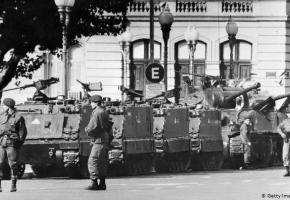Last year, Colombians around the world protested outside Colombian embassies about the violent reaction against people in Colombia who are opposing recent tax reforms and long-term injustices in Colombia. But when headlines quickly moved from Colombia to the Middle East, where Palestinians once again received the full-throttle of the Israel military machine after protesting the forced evictions of Palestinians from their homes in East Jerusalem, many Colombians seemed to be even more incensed, moving their protests from outside Colombian embassies, to outside Israeli embassies in support of Palestinians.
As Luciano Pinto of the influential social media platform @latinoshaderoom said: "The US funds both the Colombian and the Israeli military and sells them the bullets and bombs that they use on both our civilian populations. That's just the beginning of the connection."

Colombians are not the only Latin Americans who feel solidarity with the Palestinians. Last weekend, 13,000 kilometres away from Palestine, football players from the Chilean Premier League expressed their solidarity by wearing the Palestinian keffiyeh before their fixture against Colo-Colo in Santiago on Saturday.
Infact, it’s not only a political affiliation that bonds many Latin Americans to their Arab brothers and sisters, but whole history of inter-connection.
In the case of Chile, the Palestinian community numbers between 450,000 and half a million. These “Chilestinians” are a living testament to a collective Palestinian identity that existed before Israel was carved through Palestinian land in 1948. Many arrived after the creation of Israel and the ensuing war, or the ‘nakba’ (catastrophe) as Palestinians call it, but many others arrived long before.
Established in 1920, Chile's Palestino Football Club became the community’s greatest source of pride, allowing them to maintain a sense of belonging. The club only began to compete in the Chilean premier league from the 1950s, after investment by wealthy Palestinians allowed for the hiring of non-Palestinian players and professionalisation of the team. Club Palestino’s home stadium, La Cisterna, is adorned with Palestinian flags and is one of Santiago’s largest communal hubs.

The Inheritance of Spanish Prejudice
In many ways the widespread solidarity being expressed on Latino social media platforms for the Palestinians is a surprise. For Latin America has long inherited the West's narrative about the Arab world. But the solidarity perhaps reflects Latin America's long and nuanced history and contact, both direct and indirect, with Arab peoples, as well as its own conflicting experience with white-settler colonialism and US foreign policy.
The history of Arabs in Latin America goes back to the times of colonisation. While 1492 was the year that Columbus travelled from Spain to Latin America, it was also the year that los moros (the 'moors' as Spaniards referred to Arabs) were defeated on the Iberian peninsula and Christians once again ruled what is now Spain and Portugal. However, with Spain's colonisation of Latin America, the continent inherited the massive Arab influence on Spanish culture. While the Moorish influence came with the Spaniards, and can be found in beautiful colonial architecture and language (words such as ojalá come from arabic inshalla), many Africans who came to Latin America as slaves were Muslims, so Islam and broader Arab culture have been present in the Americas for hundreds of years.
Later, Arab influences came directly from the Middle East. According to Theresa Alfaro-Velcamp, associate Professor of History at Sonoma State University and author of 'So Far From Allah, So Close to Mexico: Middle Eastern Immigrants in Modern Mexico', many middle-eastern Jews and Christians fled the former Ottoman empire (from countries such as modern day Lebanon, Syria and Palestine) at the very beginning of the 20th century to avoid new conscription laws. During World War I more citizens of the Ottoman empire emigrated, fleeing mass starvation caused by an allied blockade of the Syrian coast and the Ottoman authorities confiscating food from inside the empire for military use.

World War II in Europe, drove even more people to migrate, sometimes unintentionally, to Latin America says Alfaro-Velcamp: "In some instances the immigrants were misled into believing that they were heading to the US when in fact they were destined for a Latin American Port. Many immigrants expecting the Statue of Liberty, were greeted by Rio’s Christ the Redeemer! "
Most Arabs heading for Latin America after the war, however, went to join existing family and village networks formed by earlier immigrants. Unlike their fellow Africans, brought to America by slavery, Arabs may not have looked much different to Latin Americans already there, but nevertheless began to suffer from cultural and religious, if not racial, discrimination. In 1927 the Mexican Government passed an immigration law that discriminated against ‘Syrians, Lebanese, Armenians, Palestinians, Arabs, Turks’amongst other groups that the Mexican government did not consider desirable.
That discrimination has never gone away, and increased with Arab immigrant success. Born a muslim, President Carlos Menem had to convert to Christianity even to run for election in Argentina in the 1990s. When he won a second term, middle class Argentines reacted to the re-election of Menem with a mixture of disgust and resigned humour: ‘Argentinians are like camels.....they’re exhausted by hunger and thirst but they still follow el turco’
And so... El Turco stuck with Menem, even though there’s nothing Turkish about him, whatsoever. In fact anyone of Arab descent is referred to as turco in Argentina, whether you are Syrian, Lebanese or Yemeni. For the Argentine middle classes and international media, Menem embodied all the racist muslim stereotypes; crafty, corrupt, conniving and of course the short, lascivious playboy who couldn't keep his hands off tall beautiful blonde women.
Of course, we can't not mention that it was during Menem's government that the Israeli-Argentine Cultural Centre got bombed in Buenos Aires. Theories abounded of the 'Arab connection' between Menem government and the terrorists, a possible cover-up and the supposed Hamas and Hizbollah cells present on the Paraguayan-Argentine border. But to this day, nothing was proved as to who carried out the bombing.

The Sum of Exile and Discrimination: Success
Apart from the institutionalised racism of Latin American governments, non-Arab Latin Americans have often treated Arabs with suspicion, making claims that Arab immigrants stole business from existing Latin Americans. Muslims also suffered from backlash following the September 11th attacks on the World Trade Centre.
Despite the obstacles, and much like their Jewish brothers and sisters, Latin Americans of Middle Eastern descent seem to have been successfully, disproportionately aswell as often controversially, in business and politics. Apart from Carlos Menem, Arabs have occupied the presidencies of Ecuador (Abdalá Bucaram, Jamil Mahuad), El Salvador (Antonio Saca), the Dominican Republic (Jacobo Majluta Azar) and Colombia (Julio César Turbay Ayala) and most recently Brazilian Presidential candidate Michel Temer, the son of two peasants from Btaaboura, a town 70 kilometers north of Beirut, who had settled in São Paulo in 1925.
Alfaro-Velcamp says that, while success in business can be attributed to tight family ties and the participation of entire households in business ventures (including women), the reason for such widespread political power is less clear and varies by country.
It could be said that Arab community centres have played a role in the success of Arab communities in Latin America as it gives them support and a place to network. These centres are often the focal point for middle eastern communities in large cities, and can be high profile associations. For example, the ‘Centro Libanés’ in Mexico City has high profile events with speakers such as President Felipe Calderón.
In Argentina more than 160 Arab community groups belong to a federation called ‘Confederación de Entidades Argentino Arabes’ (FEARAB - www.fearab.org.ar) which gives the group members a wide networking base. Indeed the Arab community in Argentina has a visible media presence with no less than four different TV shows: ‘Desde el ajibe’, ‘Luz de medio oriente’, ‘Dami u damak’ and ‘Las mil y una noches’. The shows discuss current affairs in the middle east and feature cultural activities such as arabic cooking demonstrations. There are also numerous Arab themed radio shows throughout the country.
Other prominent Arab Latinos include the Brazilian writers Raduan Nassar and Milton Hatoum, the great Argentinian actor Ricardo Darín (The Secrets in their Eyes) and of course Carlos Slim—the son of Lebanese immigrants and the sixth-wealthiest person in the world, according to Forbes.

Whilst men seem to have high profiles in business and politics, Latin American women have risen to success in the arts with superstars like Oscar nominated actress, director and producer Salma Hayek and Grammy award winning singer Shakira representing Latinos of Arab descent at an international level. Shakira’s Arab heritage is evident in many of her songs especially ‘Ojos Así’ and of course her belly dancing moves on 'Hips Don't Lie' have made her popular with the men as well as the ladies!
Arab influences can be found in artists other than Shakira, some reggaeton songs such as ‘Que Buena Tu Ta’ by Fuego have an eastern feel to them, and the group Tres Mundos have even released an album called ‘Bellydance Reggaeton’.
While Shakira made Arab music and dance mainstream in Latin America, Arab food has also become standard fare. From Tijuana to Santiago de Chile Latin Americans go out to enjoy Arabic food. One particularly successful example is Habib’s, a Brazilian fast food chain specialising in middle eastern cuisine that has more than 300 restaurants across Brazil. Habib’s was created when an Arab cook and Brazilian baker met by chance in the 1980s.
According to Colombian writer Luis Fayed, whilst the Christian supicion of Arabs endures in Latin America as in all parts of the world, Latin America is probably the place where the Arab community has achieved the most “complete integration of anywhere in the world". The Lebanese in Colombia feel Colombian not Lebanese, and thus do not feel the need to write about the immigrant experiences as opposed to "Arab immigrants in Europe, or (people) of other nationalities, will always write about how they’ve integrated (into the new society). They always write about that, and the difficulties they’re having, how they’ve accommodated to society. They talk about justices and injustices ... They never stop having the feeling of being from (elsewhere),” Fayed said.
In Colombia the Arab population is so integrated nobody knows who is Arab and who is not. Few would know that Wimbledon and US Open winning tennis player Robert Farah, for example was Lebanese as he presents himself always as a true Caleño patriot!

The Arabic world has a long history of cultural exchange with Latin America that continues to this day. The next time you see a girl belly dancing in a reggaeton video or a Latin American politician with an arabic last name, you can put it down to brave Middle Eastern immigrants who, in spite of difficulties and discrimination, have gone on to fulfil their Latin American dream.
At the other end of the spectrum, when it is so easy to draw similarities between the treatment of, say, indigenous Colombians by the white US-backed elites that run the goverment and Palestinians by their US-backed Israeli occupiers, it's no surprise that Colombians feel solidarity for their Arab brethren.



















